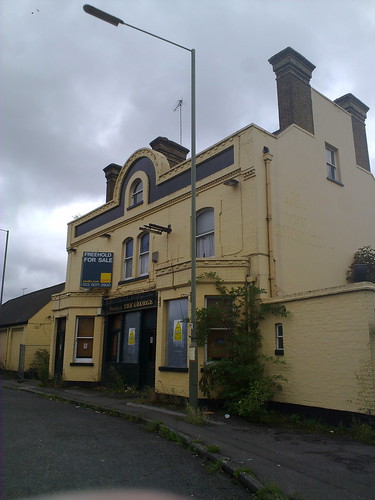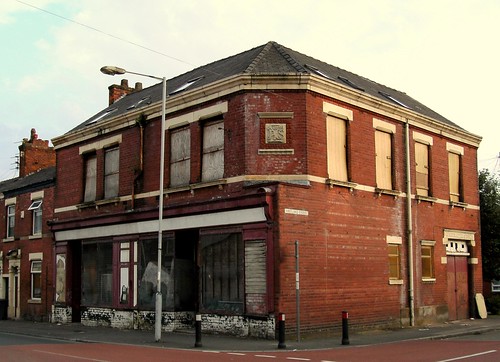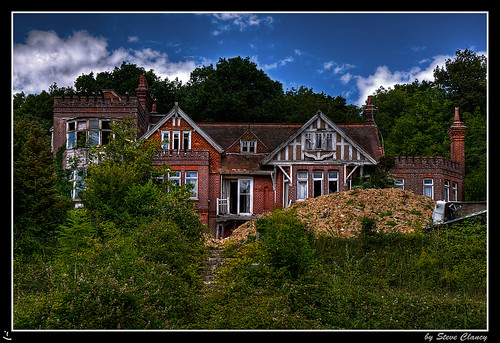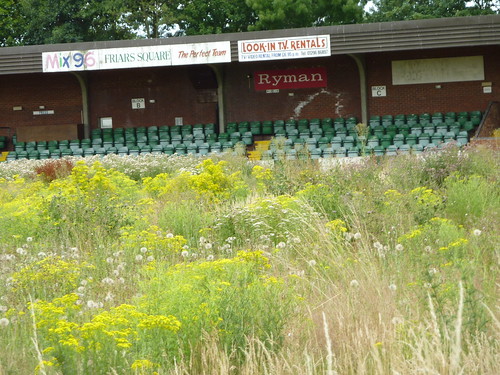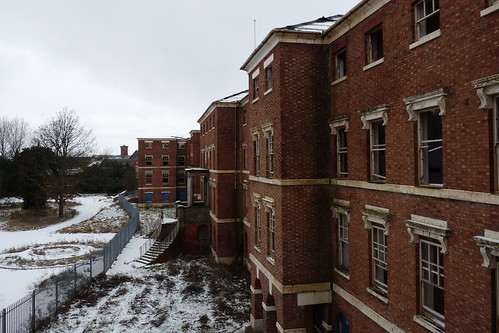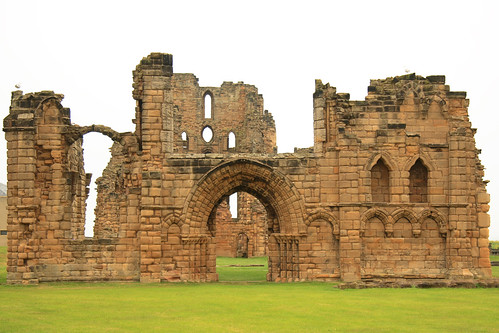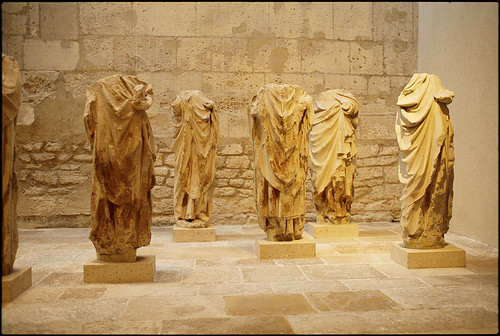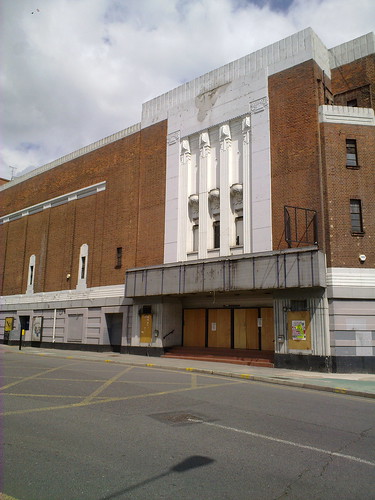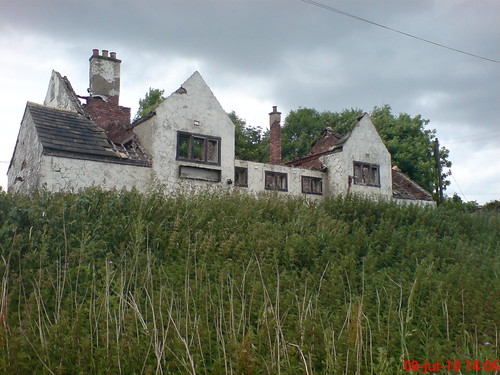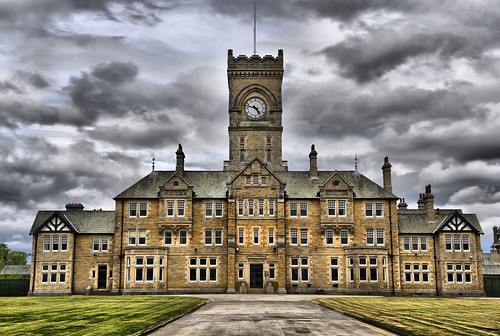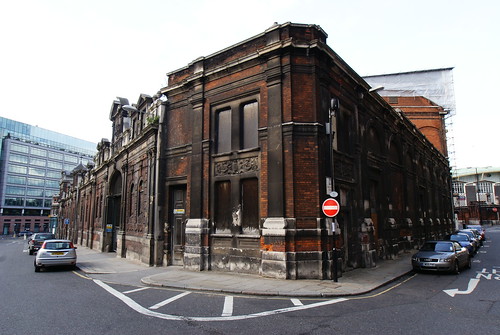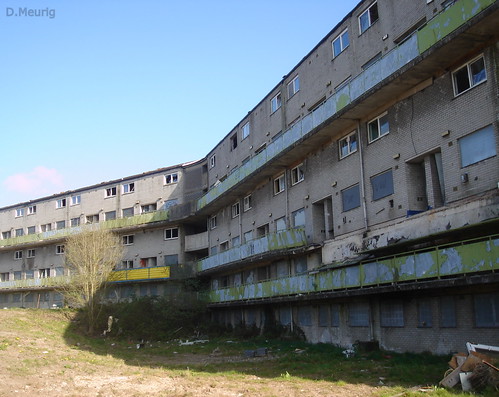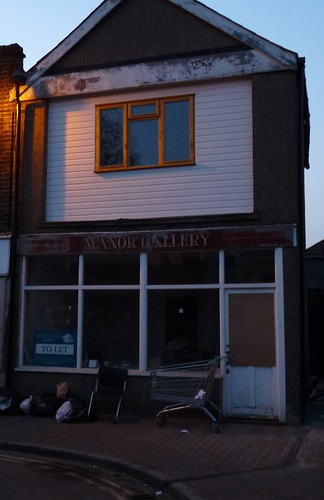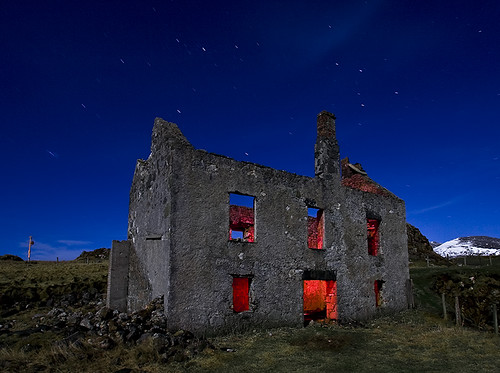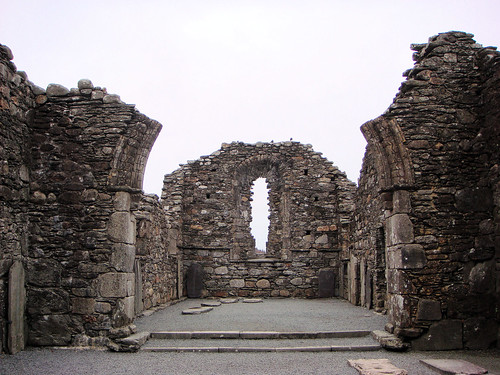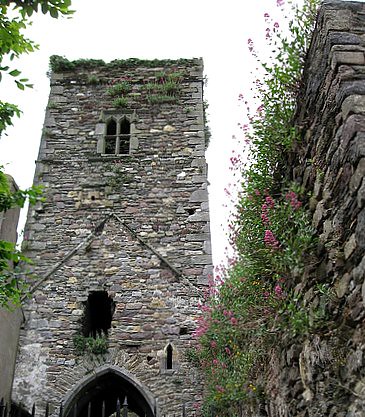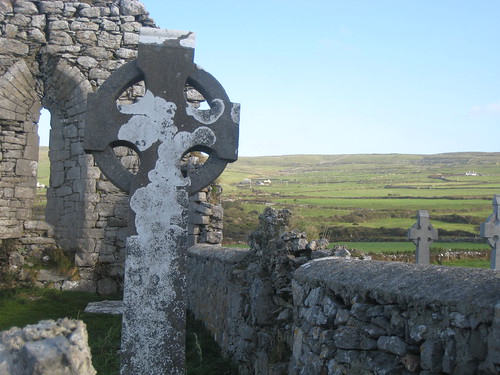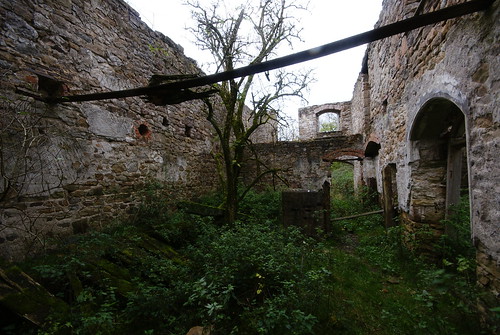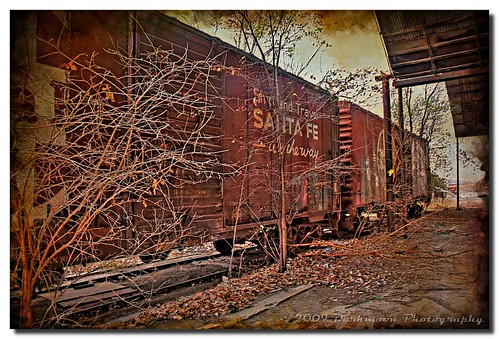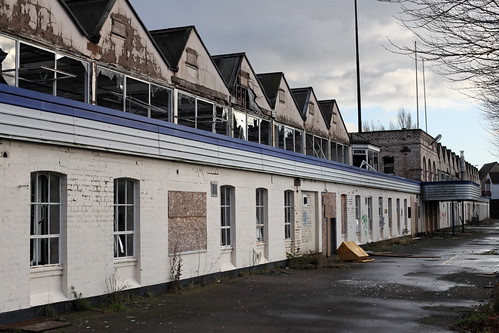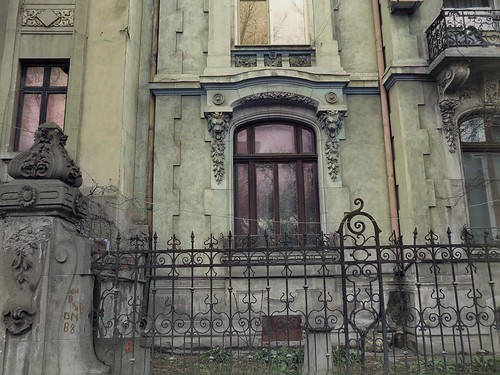
unknown location
Posted In
buildings
|
0
comments
|
![]()
Market Tavern Blaenavon
The closed Market Tavern in Blaenavon Town Centre.
|
0
comments
|
![]()
The George - Sunbury
This former pub is likely to be converted into flats
|
1 comments
|
![]()
Johns-bar
Not much left of old Glasgow. A derelict bar in the Calton
|
1 comments
|
![]()
Station Hotel, Bloxwich
Built circa 1871, now sadly empty
|
0
comments
|
![]()
Aylesbury United's former home
Aylesbury United's former Buckingham Road stadium now sadly abandoned and overgrown.
|
0
comments
|
![]()
Decapitated Kings
Decapitated statues of the Kings of France from Notre Dame cathedral,
Cluny Museum Paris 1997
|
0
comments
|
![]()
The Regal - Kingston Upon Thames
Opened on 15th February 1932, as 'The Regal Cinema' and the first film to be shown was "Splinters of the Navy" with Sydney Howard.
In 1936 Union Cinemas took over, and the name changed along with it a year later in 1937. It was in 1938, however, that Union Cinemas were taken over by ABC (Asociated British Cinemas) and the ABC's name was changed back to Regal, a year later, during 1938.
After 23 years the cinema would have it's name changed again! In August 1961 it became the ABC again. The Wurlitzer organ was removed in 1972, and taken to the 'Musical Museum' in nearby Brentford, where it can still be seen and heard today.
Closure came on July 17th 1976 after showing 'Blondie' and 'Adventures of a Taxi Driver' and it was not until 1991 that it would reopen, although only as a Coral Bingo Club. Since April 2010, Gala Bingo (who presumably took over from Coral) the building has been boarded up and closed down. Fortunately, however, it is Grade II listed.
|
0
comments
|
![]()
The World Turned Upside Down
|
0
comments
|
![]()
1971 Albion Clydesdale at rest.
Last taxed in 1986 - this can't have been parked-up since then - it's not that rusty!
However, the base of the cab and the wings show quite severe rust and the seam of the roof panel has the typical LAD cab rot.
|
0
comments
|
![]()
High Royds Asylum Admin Offices
The administration building, which is Grade II listed, is now considered something of a show piece at the former hospital, which is situated on a 300-acre (1.2 km2) site at the foot of Rombalds Moor.
It features an Italian mosaic floor in the main corridor which is intricately decorated with the Yorkshire Rose and black daisies - the latter of which provided inspiration for the title of a television screenplay, filmed at High Royds, as a tribute to sufferers of Alzheimers.
The hospital once contained a library, a surgery, a dispensary, butchers, dairies, bakers, a sweetshop, an upholster's, a cobbler's, spacious grounds, a ballroom and even a railway.
The asylum eventually closed in 2003 and is now under major redevelopment as housing and flats with the admin offices standing as the centre piece and an everlasting memorial to the sites previous historical use.
|
0
comments
|
![]()
Smithfield Fish Market, London.
Also known as Market D, this building - a former part of the much larger Smithfield Market, much of which is still in operation - combines the fish market - which appears to have been in use until around ten or fifteen years ago - with a refrigeration building known as the Red House, apparently the oldest surviving purpose-built refrigeration unit. That section appears to have been abandoned for at least thirty years or so.
|
0
comments
|
![]()
Billybanks
Derelict Billybanks Estate on the headland ridge in Penarth – Built back in the 60s, it won awards for it’s design and architecture, but suffered typical estate social deprevation issues. Plans were made to redevelop the site over 10 years ago, but progress has been slow due to some residents wishing to stay.
I’ve been hearing about this place, it’s demolition and development since moving to Cardiff – often choosing to cycle through from Pagent Road down to the Portway for a gander.
Heard that the developers have finally been given the go ahead* to start demolishing the estate this summer and build ‘Penarth Heights’**, so decided to take some photos. Some pikeys were occupying the far corner, so I’ll have to go back to have my last look of that side.
Plenty of quality photos of Billybanks on flickr – expect a lot more as it’s knocked down !
* www.penarthtimes.co.uk/news/8112908.Billybanks_redevelopm...
** www.edwardcullinanarchitects.com/projects/pen.html
|
0
comments
|
![]()
Fulham Wharf, London.
This site was originally built in 1890 as Kops Brewery, a highly successful company at the time that brewed non-alcoholic beverages. However, the decline of the temperance movement lead to non-alcoholic drinks falling from popularity, and resulted in Convoys, who packed fruit and other food and goods taking over the brewery sometime after the second world war. It is unknown when the site was abandoned, but it has clearly been vacant for a very long time now.
|
0
comments
|
![]()
Manor Gallery - Gravesend
|
0
comments
|
![]()
Rodel Ruin
Ahead of it's time? Built in the 1920s to house a hydro turbine - part of Lord Leverhulme's grand scheme for south Harris.
|
0
comments
|
![]()
Pasturized Planter
A rusting remnant of days gone by (I think it's the remains of a planter) found and photographed in a cow pasture in rural Benson County, ND.
|
0
comments
|
![]()
Fading away beneath a prairie sky
Weather beaten remnants of a family's dreams for a better life on the prairie. Found and photographed in NE Benson County, ND.
|
0
comments
|
![]()
Templar Priory & Church 2
|
0
comments
|
![]()
Templetown Priory & Church
DESTRUCTION OF THE TEMPLAR KNIGHTS
The destruction of the Templar order was relentlessly insisted upon by Philip the Fair, and accomplished with the reluctant co-operation of Clement V. In vain did the king strive to hide the sordidness of his purpose under the thin mask of religious zeal. At Clement's coronation, if not before, Philip brought charges against it. About the same time, in the insurrection called forth by his debasement of the coin, the king took refuge in the Templars' building at Paris. In 1307 he renewed the charges before the pope. When Clement hesitated, he proceeded to violence, and on the night of Oct. 13, 1307, he had all the members of the order in France arrested and thrown into prison, including Jacques de Molay, the grand-master. Doellinger applies to this deed the strong language that, if he were asked to pick out from the whole history of the world the accursed day, - dies nefastus, - he would be able to name none other than Oct. 13, 1307. Three days later, Philip announced he had taken this action as the defender of the faith and called upon Christian princes to follow his example. Little as the business was to Clement's taste, he was not man enough to set himself in opposition to the king, and he gradually became complaisant. The machinery of the Inquisition was called into use. The Dominicans, its chief agents, stood high in Philip's favor, and one of their number was his confessor. In 1308 the authorities of the state assented to the king's plans to bring the order to trial. The constitution of the court was provided for by Clement, the bishop of each diocese and two Franciscans and two Dominicans being associated together. A commission invested with general authority was to sit in Paris.
In the summer of 1308 the pope ordered a prosecution of the knights wherever they might be found. The charges set forth were heresy, spitting upon the cross, worshipping an idol, Bafomet - the word for Mohammed in the Provencal dialect - and also the most abominable offences against moral decency such as sodomy and kissing the posterior parts and the navel of fellow knights. The members were also accused of having meetings with the devil who appeared in the form of a black cat and of having carnal intercourse with female demons. The charges which the lawyers and Inquisitors got together numbered 127 and these the pope sent through France and to other countries as the basis of the prosecution.
Under the strain of prolonged torture, many of the unfortunate men gave assent to these charges, and more particularly to the denial of Christ and the spitting upon the cross. The Templars seem to have had no friends in high places bold enough to take their part. The king, the pope, the Dominican order, the University of Paris, the French episcopacy were against them. Many confessions once made by the victims were afterwards recalled at the stake. Many denied the charges altogether. In Paris 36 died under torture, 54 suffered there at one burning, May 10, 1310, and 8 days later 4 more. Hundreds of them perished in prison. Even the bitterest enemies acknowledged that the Templars who were put to death maintained their innocence to their dying breath.
In accordance with Clement's order, trials were had in Germany, Italy, Spain, Portugal, Cyprus and England. In England, Edward II. at first refused to apply the torture, which was never formally adopted in that land, but later, at Clement's demand, he complied. Papal inquisitors appeared. Synods in London and York declared the charges of heresy so serious that it would be impossible for the knights to clear themselves. English houses were disbanded and the members distributed among the monasteries to do penance. In Italy and Germany, the accused were, for the most part, declared innocent. In Spain and Portugal, no evidence was forthcoming of guilt and the synod of Tarragona, 1310, and other synods favored their innocence.
The last act in these hostile proceedings was opened at the Council of Vienne, called for the special purpose of taking action upon the order. The large majority of the council were in favor of giving it a new trial and a fair chance to prove its innocence. But the king was relentless. He reminded Clement that the guilt of the knights had been sufficiently proven, and insisted that the order be abolished. He appeared in person at the council, attended by a great retinue. Clement was overawed, and by virtue of his apostolic power issued his decree abolishing the Templars, March 22, 1312. Clement's reasons were that suspicions existed that the order held to heresies, that many of the Templars had confessed to heresies and other offences, that thereafter reputable persons would not enter the order, and that it was no longer necessary for the defence of the Holy Land. Directions were given for the further procedure. The guilty were to be put to death; the innocent to be supported out of the revenues of the order. With this action the famous order passed out of existence.
The end of Jacques de Molay, the 22d and last grand-master of the order of Templars, was worthy of its proudest days. At the first trial he confessed to the charges of denying Christ and spitting upon the cross, and was condemned, but afterwards recalled his confession. His case was reopened in 1314. With Geoffrey de Charney, grand-preceptor of Normandy, and others, he was led in front of Notre Dame Cathedral, and sentenced to perpetual imprisonment. Molay then stood forth and declared that the charges against the order were false, and that he had confessed to them under the strain of torture and instructions from the king. Charney said the same. The commission promised to reconsider the case the next day. But the king's vengeance knew no bounds, and that night, March 11, 1314, the prisoners were burned. The story ran that while the flames were doing their grewsome (sic) work, Molay summoned pope and king to meet him at the judgment bar within a year. The former died, in a little more than a month, of a loathsome disease, though penitent, as it was reported, for his treatment of the order, and the king, by accident, while engaged in the chase, six months later. The king was only 46 years old at the time of his death, and 14 years after, the last of his direct descendants was in his grave and the throne passed to the house of Valois.
As for the possessions of the order, papal decrees turned them over to the Knights of St. John, but Philip again intervened and laid claim to 260,000 pounds as a reimbursement for alleged losses to the Temple and the expense of guarding the prisoners. In Spain, they passed to the orders of San Iago di Compostella and Calatrava. In Aragon, they were in part applied to a new order, Santa Maria de Montesia, and in Portugal to the Military Order of Jesus Christ, ordo militiae Jesu Christi. Repeated demands made by the pope secured the transmission of a large part of their possessions to the Knights of St. John. In England, in 1323, parliament granted their lands to the Hospitallers, but the king appropriated a considerable share to himself. The Temple in London fell to the Earl of Pembroke, 1313.
The explanation of Philip's violent animosity and persistent persecution is his cupidity. He coveted the wealth of the Templars. Philip was quite equal to a crime of this sort. He robbed the bankers of Lombardy and the Jews of France, and debased the coin of his realm. A loan of 500,000 pounds which he had secured for a sister's dowry had involved him in great financial straits. He appropriated all the possessions of the Templars he could lay his hands upon. Clement V.'s subserviency it is easy to explain. He was a creature of the king. When the pope hesitated to proceed against the unfortunate order, the king beset him with the case of Boniface VIII. To save the memory of his predecessor, the pope surrendered the lives of the knights. Dante, in representing the Templars as victims of the king's avarice, compares Philip to Pontius Pilate.
"I see the modern Pilate, whom avails
No cruelty to sate and who, unbidden,
Into the Temple sets his greedy sails."
(Purgatory, xx. 91)
The house of the Templars in Paris was turned into a royal residence, from which Louis XVI., more than four centuries later, went forth to the scaffold.
The Council of Vienne, the fifteenth in the list of the oecumenical councils, met Oct. 16, 1311, and after holding three sessions adjourned six months later, May 6, 1812. Clement opened it with an address on Psalm 111:1, 2, and designated three subjects for its consideration, the case of the order of the Templars, the relief of the Holy Land and Church reform. The documents bearing on the council are defective. In addition to the decisions concerning the Templars and Boniface VIII., it condemned the Beguines and Beghards and listened to charges made against the Franciscan, Peter John Olivi (d. 1298). Olivi belonged to the Spiritual wing of the order. His books had been ordered burnt, 1274, by one Franciscan general, and a second general of the order, Bonagratia, 1279, had appointed a commission which found thirty-four dangerous articles in his writings. The council, without pronouncing against Olivi, condemned three articles ascribed to him bearing on the relation of the two parties in the Franciscan order, the Spirituals and Conventuals.
The council has a place in the history of biblical scholarship and university education by its act ordering two chairs each, of Hebrew, Arabic, and Chaldee established in Paris, Oxford, Bologna, and Salamanca.
While the proceedings against Boniface and the Templars were dragging on in their slow course in France, Clement was trying to make good his authority in Italy. Against Venice he hurled the most violent anathemas and interdicts for venturing to lay hands on Ferrara, whose territory was claimed by the Apostolic See. A crusade was preached against the sacrilegious city. She was defeated in battle, and Ferrara was committed to the administration of Robert, king of Naples, as the pope's vicar.
|
0
comments
|
![]()
Templeton Priory & Church (8)
One member of this little society was Eustace Budgell, a young Templar of some literature, and a distant relation of Samuel Addison. There was at this time no stain on the character of Budgell, and it is not improbable that his career would have been prosperous and honourable, if the life of his cousin had been prolonged. But when the master was laid in the grave, the disciple broke loose from all restraint, descended rapidly from one degree of vice and misery to another, ruined his fortune by follies, attempted to repair it by crimes, and at length closed a wicked and unhappy life by self-murder. Yet, to the last, the wretched man, gambler, lampooner, cheat, forger, as he was, retained his affection and veneration for Addison, and recorded those feelings in the last lines which he traced before he hid himself from infamy under London Bridge.
|
0
comments
|
![]()
Since it's St. Patrick's Day...some Irish graves...
|
0
comments
|
![]()
The stables of the Piercefield Estate.
I wonder how long these have been derelict for... I seriously doubt from the state of them that they've been left since 1921, as the main mansion has
|
0
comments
|
![]()
row of abandoned houses
Posted In
buildings
|
0
comments
|
![]()
Indian Arm power station...
|
0
comments
|
![]()
Bismarckturm in Wuppertal/Germany (HDR)
|
0
comments
|
![]()
THE OLD HOUSE OF DR. DeNOIRE - THE BUTCHER OF THE LOST SOULS
|
0
comments
|
![]()
Eastern architecture
In the Turkish region of Cappadocia
|
0
comments
|
![]()

